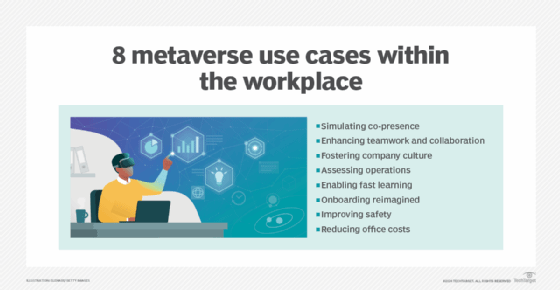How will the metaverse affect the future of work?
Virtual field trips to the Louvre for inspiration, accelerated learning, onboarding reimagined -- how will the metaverse change our working environments and when? It depends.
The metaverse has the potential to radically change how we work. But how exactly a 3D internet -- the shorthand description of the metaverse -- will transform work environments is not yet known. This is partly because the technology required to fundamentally transform workflows is not fully realized and in part because it's unclear how customers will use the metaverse.
Proponents argue that, done right, the virtual worlds of the metaverse will increase teleworker camaraderie, improve collaboration, speed up training, reduce the need for office space and make work a happier place in general. At least that's the promise in pitches like this demo from social media mogul Mark Zuckerberg, whose rebranding of Facebook into Meta in late 2021 galvanized business interest in a concept that is simultaneously not new and does not yet exist.
This article lays out the latest thinking on how the metaverse could have an impact on work environments and when.
What is the metaverse?
The term metaverse, coined by sci-fi writer Neal Stephenson in his 1992 novel Snow Crash, generally refers to a shared, persistent 3D digital world where people work and play.
Matthew Ball, author of what is widely considered one of the best primers on the metaverse, defines this world as having the following features:
- Massively scalable, interoperable, real-time 3D.
- Synchronicity and persistence.
- Continuity of data, identity, history, entitlements, objects and payments across worlds.
As Ball and others point out, the technology to realize many of these required features is still a work in progress. For example, we have 3D worlds, but they don't scale easily beyond a few hundred users attending a conference broadcast -- and they support far fewer people if there is any sort of interaction involved. There is, at present, very little continuity of history, entitlement and objects across virtual worlds. It could take another five to 10 years to sort out the technical issues for doing this. It could take even longer to sort out business agreements and data privacy issues.
So, the timing of the metaverse depends on who's talking and the level of complexity they are considering. At one end, Microsoft Chairman and CEO Satya Nadella has said the metaverse is already here if we are just talking about embedding the real world into the digital world through applications such as Mesh Team Meetings and HoloLens overlays on factory floors. At the Meta Connect 2021 event, Zuckerberg said he expects an "embodied" metaverse to become mainstream over the next five to 10 years if we are talking about larger-scale virtual worlds that we visit with high-performance hardware.
How to adapt the metaverse for work
Creating the metaverse for work will require businesses to rethink how people use new digital tools rather than just bring the existing office into a virtual office. Indeed, early research suggests that simply translating existing offices into a 3D equivalent can reduce productivity for existing tasks and even cause nausea and motion sickness. Here are some insights from four experts on transitioning work to the metaverse:
Tuong H. Nguyen, senior principal analyst at Gartner, pointed out that what we have presently are "precursors" or "pre-metaverse" implementations. "While no one can say with certainty how the metaverse will turn out -- let alone its impact on any segment, vertical or geography -- these precursors provide an educated guess on how it would potentially impact us."
One of these precursors is virtual reality (VR), which Nguyen emphasized is not the metaverse. VR is an experience or interface, while the metaverse is a digital ecosystem, he underscored. Moreover, VR is only one of many ways to interact with this digital ecosystem and might not necessarily be the most important interface nor the one most used. Still, Nguyen said Gartner sees benefits to using VR to improve meetings, product configuration, product design, decision-making, onboarding and training.
Andrew Hawken, co-founder and CEO of Mesmerise, which makes tools for 3D collaboration, said he believes the metaverse represents "an opportunity to shrink the world in the same way the internet did in the 90s." But he said it is essential to level-set expectations on how new metaverse precursors like VR are the most effective. Hawken cautioned that VR is a "sometimes tool" rather than an all-day tool. His team has found that 20 minutes is often the ideal session length for a meeting in VR.
Frank Diana, managing partner and futurist at Tata Consultancy Services, likened the workplace shift to the metaverse to the transition from typing pools to having an entire workforce typing into personal computers. However, while working in the metaverse will make many workflows easier, it also threatens to eliminate many existing jobs. "We need to reskill workers to teach them how to operate effectively in the metaverse so that otherwise effective employees aren't left behind and [don't] become technologically unemployable," Diana said.
Marcel Hollerbach, chief innovation officer at Productsup, a product information management platform, said it's also important to proceed methodically into the metaverse to see what works and what creates problems. Remote work offers a pathway. By working the metaverse into the core structure of remote work, he said, employees will become more accustomed to using the technology and more receptive to its purpose.

Metaverse in the workplace: 8 use cases
Here are some of the top use cases of work in the metaverse:
1. Simulating co-presence
Company employees are increasingly separated from each other, working at home or in different offices.
"We've all come to realize that co-presence -- the feeling of being in the same room as someone -- has so many benefits in terms of communication, engagement, morale, team culture and more," Hawken said.
New metaverse experiences could emulate the social interactions we are used to experiencing in life meetings and events. Enabling technology could run the gamut from spatial audio to help place individuals in a virtual room to new ways of arranging people at larger meetings on a 2D screen to immersive 3D virtual reality experiences.
"The ability of the metaverse to provide experiences that can be as collaborative and socially satisfying as in-person interactions will enable companies to create workforces that are incredibly distributed and diverse," Diana said.
2. Enhancing teamwork and collaboration
New metaverse experiences might also make collaboration even better than in the real world. In-person ideation generally involves whiteboards, sticky notes and large screen monitors.
"What if there are boundaryless 3D collaboration tools in the metaverse and the team could transport themselves to the Louvre Museum for inspiration?" Diana asked. "If working remotely in the metaverse provides both increased productivity and better collaboration, today's office model gets totally upended."
Matterport, a tech company whose 3D modeling software digitally replicates physical spaces, has been developing digital twin workflows that let employees collaborate, learn and engage remotely. For example, architects can virtually collaborate with clients on remodeling ideas to make faster decisions, and retailers can virtually collaborate on different store layouts to discover problems or opportunities sooner.
"All of this has the power to help organizations realize significant cost and time savings," said Steve Lombardi, vice president of communications and business affairs at Matterport.
3. Fostering company culture
Hollerbach said his team began experimenting with new metaverse tools to address the tedium of staring and talking at a screen with little to no opportunities to interact with others. He has found this helpful for team-building exercises, company events and employee training.
"It presents an entirely new way for people to connect socially," he said. "Instead of feeling separated from your colleagues by hundreds of miles, you are brought into the same environment. Plus, people are intrigued by what the metaverse has to offer," Hollerbach said.
4. Assessing operations
The metaverse could also make it easier for executives to visit a factory, distribution center or construction site on the other side of the city or the world, letting them assess the current state of things, simulate the impact of changes and collaborate with far-flung employees to solve problems.
"They'll be able to see and touch its machines, shake hands with the local supervisor and inspect its operations without leaving their desk," said Emmanuelle Rivet, vice chair, U.S. TMT and Global Technology Leader, at PwC.
5. Enabling fast learning
The metaverse could also enhance skills and training methods. The metaverse will permit interactive gameplay and simulations for learning. Employees could learn to operate a machine as if in "real life" or practice a sales presentation for a big-money client, to cite just two examples, said Daniel Fallmann, CEO and co-founder at Mindbreeze, a knowledge management platform.
"New workers won't have to rely on handbooks and training manuals," he said.
6. Onboarding reimagined
Diana predicts that the mixed reality and metaverse training and onboarding sessions will become the norm across companies in the coming years. "The metaverse will allow us to completely reimagine the onboarding experience, not simply extend today's in-person onboarding to a virtual world," he said.
Rather than reading another document or video about the history of a company, new employees could meet the founder or visit the job site. The metaverse could also help hires create social connections with their new teams.
7. Improving safety
Metaverse onboarding could also reduce risks for first responders, hospital emergency personnel and military personnel. "Dangerous and stressful situations can be simulated in a way that prepares these workers for real-life situations without putting them in real danger and, eventually, at a much lower cost," Diana said.
8. Reducing office costs
The broader adoption of metaverse platforms could increase employee engagement irrespective of where they are. "This will help savvy enterprises attract needed talent without worrying about the physical offices," said Yugal Joshi, partner at Everest Group, an advisory firm.
Challenges of moving work to the metaverse
The metaverse will not be a slam dunk for many organizations or even a success story for some of the top use cases described above. Making a splashy entrance is one thing. Getting traction in the metaverse will require sorting out issues like ergonomics, security and workflows, among other challenges:
- Metaverse fatigue. A recent German study found extensive ergonomic issues when translating desk-based tasks into VR for a week. Two participants out of 16 had to drop out due to simulator sickness, while the others suffered reduced performance, eyestrain and frustration. However, there was some evidence that participants gradually overcame initial discomfort.
"We have heard of Zoom fatigue during the initial shift to remote -- we may see metaverse fatigue unless superior user experiences are guaranteed," Diana said. - Diminished diversity and inclusiveness. Creating an equal opportunity, diverse and inclusive environment is challenging enough in the physical world, Joshi said. He is concerned that the metaverse could impede progress if it is not used correctly. There are already examples of sexual abuse and harassment of avatars of women in the metaverse, he said. In addition, many of today's relatively simple applications are not always accessible to people with disabilities, and the metaverse will be more complex. Accessing metaverse platforms could also require expensive hardware that some people cannot afford. Even now, employees who lack strong broadband can miss out on team activities.
- Security and privacy threats. Enterprises will also need to address new security threats and privacy issues in the metaverse. Augmented reality (AR), mixed reality and VR technologies capture rich biometric data, facial features and unique gestures. "If not secured, these could be used to steal identities and even create invasive deepfakes," Diana said.
- Integrating AR and VR into workflows. Nguyen said enterprises must also work out the kinks of incorporating AR and VR tools into workflows to complement existing tools. Just as companies had to figure out when and where video calls made the most sense, they will also need an ongoing process to discover when and where AR and VR are applicable.
The evolution of work is a work in progress
Getting our arms around the metaverse will quite literally be difficult. "The metaverse is not a place or a thing that you can physically hold," Nguyen said. "The metaverse is an evolution of the internet," and because it is evolving, it is difficult for companies to predict how it will play out and where they belong in it, he added.
Each enterprise will have to explore how the nature of jobs could change in the wake of an immersive digital environment and persistent, decentralized, collaborative, interoperable digital content. Anchoring digital information to machines will enable new repair and installation workflows for technicians and customers. Adaptive digital signs and price tags could change retail jobs. Collaborative 3D simulations will change the way we make complex decisions -- and these are just a fraction of the ways virtual worlds will transform work.
George Lawton is a journalist based in London. Over the last 30 years he has written more than 3,000 stories about computers, communications, knowledge management, business, health and other areas that interest him.






